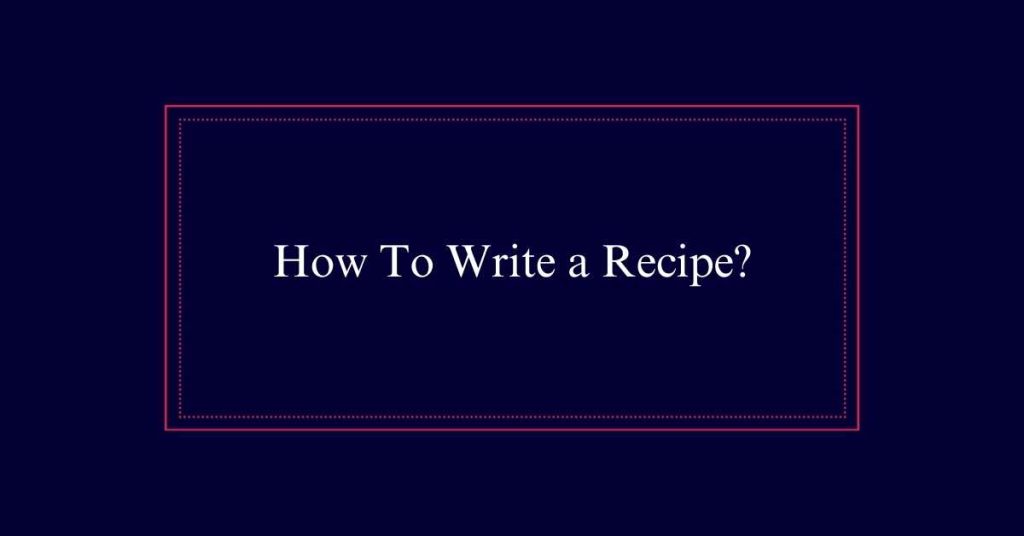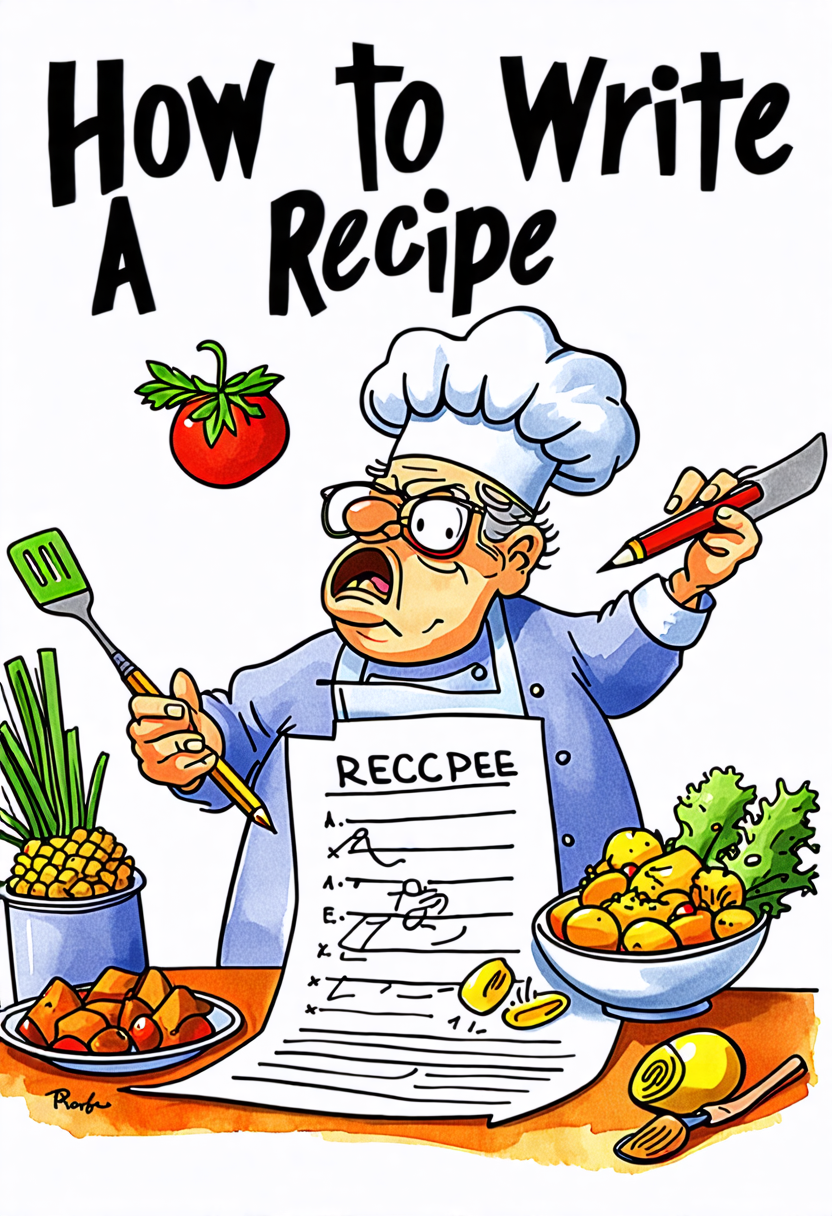How To Write a Recipe?
Creating a clear and effective recipe involves several essential steps. Begin by visualizing the entire cooking process, including the presentation and flavors of the final dish. Organize your cooking space for efficiency by clearing countertops and arranging tools within easy reach. Gather all necessary ingredients and prepare them in advance, ensuring precise measurements. Use basic utensils like measuring cups, knives, mixing bowls, and a reliable cutting board. Write clear, step-by-step instructions for consistency.
Preparing for Success
To guarantee successful recipe creation, start by envisioning the entire cooking process from start to finish. Consider the space you’ll use, ensuring it’s clean and organized. Gather all necessary ingredients and tools before beginning. This preparation saves time and reduces stress. Plan the time needed for each step, including prep and cook times.
A recipe’s key components are its introduction, ingredients, directions, and title. The introduction should set the context and share your personal connection to the dish. Ingredients must be listed in order of use with precise measurements. Directions should be clear and concise, with specific times and temperatures. Finally, choose a descriptive and engaging title to draw readers in and give a clear idea of the dish.
Visualizing the Dish
Envisioning the final dish will guide you in creating a recipe that is both practical and appealing. Picture the colors, textures, and presentation of the finished product. This mental image helps in describing each step accurately.
Think about how the ingredients blend together. Consider their order of use and how they interact during cooking. Visualizing also aids in determining portion sizes and plating techniques.
Imagine the aromas and tastes. This can inspire useful tips for enhancing flavor. By seeing the dish in your mind, you guarantee that your directions lead to a consistent outcome. Your goal is to make it easy for others to replicate the dish successfully.
Planning Your Space
Properly planning your space guarantees an efficient and stress-free cooking experience. Begin by clearing your countertops. Secure ample space for chopping, mixing, and assembling ingredients.
Arrange your tools within reach. Place knives, cutting boards, and mixing bowls nearby. Organize your stove area, keeping pots, pans, and utensils close. Maintain a clean sink for washing produce and utensils. Assure good lighting, especially over work areas.
Consider a trash bowl or bin for easy disposal of scraps. Create a workflow that minimizes movement and maximizes efficiency. Label containers to avoid confusion. Remember, a well-organized kitchen allows you to focus on cooking, reducing stress and mistakes.
Gathering Ingredients
Gather all necessary ingredients before starting to cook. This guarantees a smooth cooking process. Make a checklist of ingredients to avoid missing anything. Organize the ingredients in the order of use for efficiency. Use precise measurements to maintain consistency in your recipe.
| Ingredient | Measurement |
|---|---|
| Flour | 2 cups |
| Sugar | 1 cup |
| Butter (melted) | 1/2 cup |
| Eggs | 2 |
Specify each ingredient clearly. Use terms like ‘melted’ or ‘chopped’ to guide the reader. Differentiate components if your recipe has parts, like a cake and its frosting. Consistent abbreviations help in understanding. Preparing ingredients in advance will streamline the cooking process, guaranteeing a better outcome.

Essential Tools
What essential tools are needed to create a seamless cooking experience?
Begin with basic utensils like measuring cups and spoons for accuracy.
A good set of knives is vital for chopping and slicing.
Mixing bowls of various sizes help keep ingredients organized.
Use a reliable cutting board to prevent damage to your countertops.
A sturdy whisk and a set of spatulas make mixing and folding easier.
Invest in quality pots and pans for even cooking.
Baking requires specific tools like a rolling pin and baking sheets.
Don’t forget a timer to keep track of cooking times.
Lastly, a digital thermometer guarantees food is cooked to the right temperature.
Crafting the Introduction
Crafting the introduction sets the stage for your recipe and engages your readers from the start. Begin by sharing a personal connection to the dish. This could be a family tradition or a memorable occasion. Mention the serving size, prep time, and cook time to give readers an idea of what to expect.
Set the occasion for the recipe. Is it perfect for a cozy winter night or a summer barbecue? This helps readers visualize when to make the dish. Keep your language simple and inviting. The goal is to make readers excited to try the recipe.
Listing Ingredients
When listing ingredients, always make sure they are presented in the order they will be used in the recipe. This helps the cook follow the process smoothly.
Specify exact measurements for each ingredient, such as ‘1 cup of sugar’ or ‘2 teaspoons of salt.’ Use standard abbreviations like ‘tsp’ for teaspoon and ‘tbsp’ for tablespoon. Consistency is key.
If your recipe has different components, like a sauce and a main dish, differentiate them clearly. For example, write ‘For the sauce:’ followed by its ingredients. Use descriptive terms like ‘chopped,’ ‘melted,’ or ‘diced‘ to provide clarity.
Writing Clear Directions
To guarantee success, provide clear and concise instructions for each step of the recipe. Use simple, practical language to avoid confusion.
Assure each step is easy to follow by breaking down the process.
Number the steps and use short, direct sentences. Include specific details like cooking times and temperatures.
For example, write ‘Bake at 350°F for 20 minutes’ instead of ‘Bake until done.’
Mention any special techniques or tips that can help, such as ‘Stir continuously to prevent sticking.
Avoid unnecessary adjectives that may complicate understanding.
Remember to structure the steps logically, guiding the reader from start to finish smoothly.
This approach ensures that even beginners can recreate the dish successfully.
Creating the Title
Now that your directions are clear, let’s focus on crafting an engaging and descriptive title for your recipe. The title is the first impression readers get of your dish. It should be creative and descriptive, offering a clear idea of what the recipe entails. Avoid misleading or confusing titles. Aim for fun while ensuring clarity.
| Example 1 | Example 2 | Example 3 |
|---|---|---|
| “Spicy Garlic Shrimp” | “Creamy Mushroom Pasta” | “Lemon Herb Chicken” |
| Clear and descriptive | Highlights key ingredient | Highlights flavor profile |
| Reader knows it’s spicy | Reader expects creaminess | Reader expects lemon flavor |
| Specific and inviting | Clear and appetizing | Engaging and clear |
Final Touches
Adding final touches can elevate your recipe from good to exceptional. First, review your recipe for clarity. Guarantee all steps are easy to follow. Check for consistency in measurements and descriptive terms.
Next, add any tips or variations. Suggest substitutions for common allergens or dietary preferences. Include storage advice for leftovers.
Consider adding a photo of the finished dish. A visual can guide cooks and entice them to try your recipe.
Frequently Asked Questions
How Do I Ensure My Recipe Is Accessible for Beginners?
To guarantee your recipe is accessible for beginners, use simple vocabulary and short, clear sentences. Break down steps into manageable parts, specify exact measurements, and provide visual cues. Include detailed instructions for basic techniques and tools.
What Should I Do if My Recipe Fails During Testing?
If your recipe fails during testing, revisit each step. Identify where issues arose. Adjust ingredients, cooking times, or methods. Test again. Document changes. Guarantee clarity and accuracy. Repeat until consistent results are achieved.







